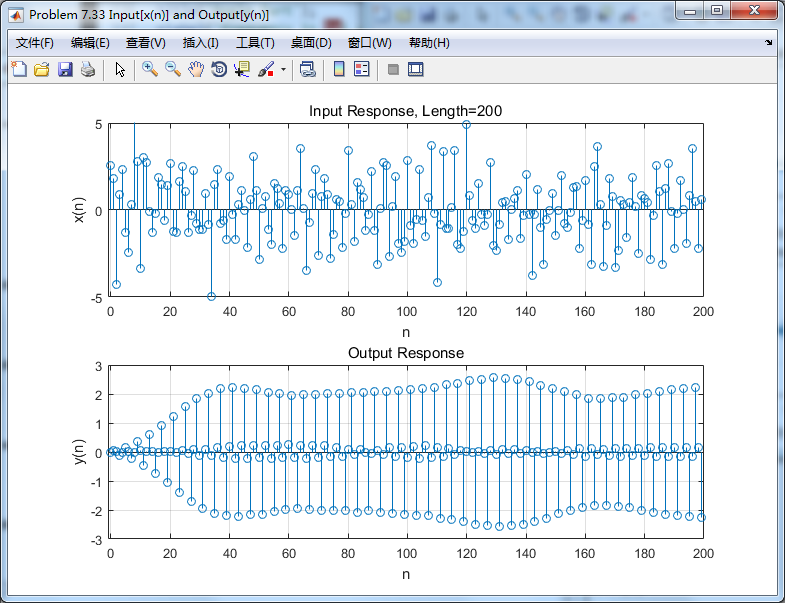
代码:
%% ++++++++++++++++++++++++++++++++++++++++++++++++++++++++++++++++++++++++++++++++%% Output Info about this m-filefprintf('\n***********************************************************\n');fprintf(' Problem 7.33 \n\n');banner();%% ++++++++++++++++++++++++++++++++++++++++++++++++++++++++++++++++++++++++++++++++ws1 = 0.44*pi; wp1 = 0.49*pi; wp2 = 0.51*pi; ws2=0.56*pi; As = 30; Rp = 1.0;[delta1, delta2] = db2delta(Rp, As)weights = [1 delta2/delta1 1]deltaH = max([delta1,delta2]); deltaL = min([delta1,delta2]);%Dw = min((wp1-ws1), (ws2-wp2));%M = ceil((-20*log10((delta1*delta2)^(1/2)) - 13) / (2.285*Dw) + 1)M = 51;f = [ 0 ws1 wp1 wp2 ws2 pi]/pi;m = [ 0 0 1 1 0 0];h = firpm(M-1, f, m, weights);[db, mag, pha, grd, w] = freqz_m(h, [1]);delta_w = 2*pi/1000; ws1i = floor(ws1/delta_w)+1; wp1i = floor(wp1/delta_w)+1;wp2i = floor(wp2/delta_w)+1; ws2i = floor(ws2/delta_w)+1;Asd = -max(db(1:ws1i))%[Hr, ww, a, L] = Hr_Type1(h);[Hr,omega,P,L] = ampl_res(h);l = 0:M-1;%% -------------------------------------------------%% Plot%% ------------------------------------------------- figure('NumberTitle', 'off', 'Name', 'Problem 7.33 Parks-McClellan Method')set(gcf,'Color','white'); subplot(2,2,1); stem(l, h); axis([-1, M, -0.1, 0.1]); grid on;xlabel('n'); ylabel('h(n)'); title('Actual Impulse Response, M=51');set(gca,'XTickMode','manual','XTick',[0,M-1])set(gca,'YTickMode','manual','YTick',[-0.3:0.1:0.4])subplot(2,2,2); plot(w/pi, db); axis([0, 1, -80, 10]); grid on;xlabel('frequency in \pi units'); ylabel('Decibels'); title('Magnitude Response in dB ');set(gca,'XTickMode','manual','XTick',f)set(gca,'YTickMode','manual','YTick',[-60,-30,0]);set(gca,'YTickLabelMode','manual','YTickLabel',['60';'30';' 0']);subplot(2,2,3); plot(omega/pi, Hr); axis([0, 1, -0.2, 1.2]); grid on;xlabel('frequency in \pi nuits'); ylabel('Hr(w)'); title('Amplitude Response');set(gca,'XTickMode','manual','XTick',f)set(gca,'YTickMode','manual','YTick',[0,1]);delta_w = 2*pi/1000; subplot(2,2,4); axis([0, 1, -deltaH, deltaH]); sb1w = omega(1:1:ws1i)/pi; sb1e = (Hr(1:1:ws1i)-m(1)); %sb1e = (Hr(1:1:ws1i)-m(1))*weights(1);pbw = omega(wp1i:wp2i)/pi; pbe = (Hr(wp1i:wp2i)-m(3)); %pbe = (Hr(wp1i:wp2i)-m(3))*weights(2);sb2w = omega(ws2i:501)/pi; sb2e = (Hr(ws2i:501)-m(5)); %sb2e = (Hr(ws2i:501)-m(5))*weights(3);plot(sb1w,sb1e,pbw,pbe,sb2w,sb2e); grid on;xlabel('frequency in \pi units'); ylabel('Hr(w)'); title('Error Response'); %title('Weighted Error');set(gca,'XTickMode','manual','XTick',f);%set(gca,'YTickMode','manual','YTick',[-deltaH,0,deltaH]);figure('NumberTitle', 'off', 'Name', 'Problem 7.33 AmpRes of h(n), Parks-McClellan Method')set(gcf,'Color','white'); plot(omega/pi, Hr); grid on; %axis([0 1 -100 10]); xlabel('frequency in \pi units'); ylabel('Hr'); title('Amplitude Response');set(gca,'YTickMode','manual','YTick',[-0.0334,0, 0.0334,1,1.057]);%set(gca,'YTickLabelMode','manual','YTickLabel',['90';'40';' 0']);set(gca,'XTickMode','manual','XTick',[0,0.44,0.49,0.51,0.56,1]);%% -------------------------------------------------------%% Input is given, and we want the Output%% -------------------------------------------------------num = 200; mean_val=0; variance=1;x2 = mean_val + sqrt(variance)*randn(num,1);n_x2 = 0:num-1;x_axis = min(x2):0.02:max(x2);figure('NumberTitle', 'off', 'Name', 'Problem 7.33 hist');set(gcf,'Color','white'); %hist(x1,x_axis); hist(x2,100);title('Gaussian Distributed Random Numbers (using hist)');xlabel('n'); ylabel('x2(n)'); grid on;figure('NumberTitle', 'off', 'Name', 'Problem 7.33 bar');set(gcf,'Color','white'); %[counts,binlocal] = hist(x1, x_axis);[counts,binlocal] = hist(x2, 100);counts = counts/num;bar(binlocal, counts, 1); title('Gaussian Distributed Random Numbers (using bar)');xlabel('n'); ylabel('x2(n)'); grid on;% Inputn_x3 = [0:1:num-1];x3 = 2*cos(n_x3*pi/2);[x,n_x] = sigadd (x2, n_x2, x3, n_x3);y = filter(h, 1, x);n_y = n_x;figure('NumberTitle', 'off', 'Name', 'Problem 7.33 Input[x(n)] and Output[y(n)]');set(gcf,'Color','white');subplot(2,1,1); stem(n_x, x); axis([-1, 200, -5, 5]); grid on;xlabel('n'); ylabel('x(n)'); title('Input Response, Length=200');subplot(2,1,2); stem(n_y, y); axis([-1, 200, -3, 3]); grid on;xlabel('n'); ylabel('y(n)'); title('Output Response');% ---------------------------% DTFT of x and y% ---------------------------MM = 500;[X, w1] = dtft1(x, n_x, MM);[Y, w1] = dtft1(y, n_y, MM);magX = abs(X); angX = angle(X); realX = real(X); imagX = imag(X);magY = abs(Y); angY = angle(Y); realY = real(Y); imagY = imag(Y);figure('NumberTitle', 'off', 'Name', 'Problem 7.33 DTFT of Input[x(n)]')set(gcf,'Color','white'); subplot(2,2,1); plot(w1/pi,magX); grid on; %axis([0,2,0,15]); title('Magnitude Part');xlabel('frequency in \pi units'); ylabel('Magnitude |X|'); subplot(2,2,3); plot(w1/pi, angX/pi); grid on; axis([0,2,-1,1]);title('Angle Part');xlabel('frequency in \pi units'); ylabel('Radians/\pi');subplot(2,2,2); plot(w1/pi, realX); grid on;title('Real Part');xlabel('frequency in \pi units'); ylabel('Real');subplot(2,2,4); plot(w1/pi, imagX); grid on;title('Imaginary Part');xlabel('frequency in \pi units'); ylabel('Imaginary');figure('NumberTitle', 'off', 'Name', 'Problem 7.33 DTFT of Output[y(n)]')set(gcf,'Color','white'); subplot(2,2,1); plot(w1/pi,magY); grid on; %axis([0,2,0,15]); title('Magnitude Part');xlabel('frequency in \pi units'); ylabel('Magnitude |Y|'); subplot(2,2,3); plot(w1/pi, angY/pi); grid on; axis([0,2,-1,1]);title('Angle Part');xlabel('frequency in \pi units'); ylabel('Radians/\pi');subplot(2,2,2); plot(w1/pi, realY); grid on;title('Real Part');xlabel('frequency in \pi units'); ylabel('Real');subplot(2,2,4); plot(w1/pi, imagY); grid on;title('Imaginary Part');xlabel('frequency in \pi units'); ylabel('Imaginary');figure('NumberTitle', 'off', 'Name', 'Problem 7.33 Magnitude Response')set(gcf,'Color','white'); subplot(1,2,1); plot(w1/pi,magX); grid on; %axis([0,2,0,15]); title('Magnitude Part of Input');xlabel('frequency in \pi units'); ylabel('Magnitude |X|'); subplot(1,2,2); plot(w1/pi,magY); grid on; %axis([0,2,0,15]); title('Magnitude Part of Output');xlabel('frequency in \pi units'); ylabel('Magnitude |Y|'); 运行结果:
设计一个50阶(即长度M=51)的线性相位FIR,通带宽度不超过0.02π,阻带衰减达到30dB,
最后要把输入中的高斯噪声过滤掉。
As=33dB,满足设计要求。

用P-M方法设计的脉冲响应幅度谱,

振幅谱

输入信号


滤波前后,输入数出对比

输入输出的谱:


右下图可见,随即噪声分量已滤除,仅留0.5π频率分量,效果良好。
